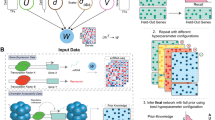Abstract.
Identification of rate-limiting steps or components of intracellular second messenger systems holds promise to effectively interfere with these pathways under pathological conditions. The emerging literature on a recently identified family of signalling regulator proteins, called tribbles gives interesting clues for how these proteins seem to link several ‘independent’ signal processing systems together. Via their unique way of action, tribbles co-ordinate the activation and suppression of the various interacting signalling pathways and therefore appear to be key in determining cell fate while responding to environmental challenges. This review summarises our current understanding of tribbles function and also provides an evolutionary perspective on the various tribbles genes.
Similar content being viewed by others
Author information
Authors and Affiliations
Corresponding author
Additional information
Received 10 January 2006; received after revision 20 March 2006; accepted 5 April 2006
Rights and permissions
About this article
Cite this article
Hegedus, Z., Czibula, A. & Kiss-Toth, E. Tribbles: novel regulators of cell function; evolutionary aspects. Cell. Mol. Life Sci. 63, 1632–1641 (2006). https://doi.org/10.1007/s00018-006-6007-9
Published:
Issue Date:
DOI: https://doi.org/10.1007/s00018-006-6007-9




